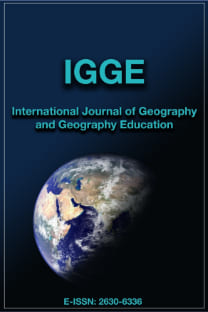COĞRAFİ ORTAM VE KENT FİZYOLOJİSİ İLİŞKİLERİ: XIX. YÜZYIL KİLİS ŞEHRİ ÖRNEĞİ
Coğrafya, Tarihi Coğrafya, Kilis, Gaziantep, Kent Şehiriçi Arazi Kullanımı, XIX. Yüzyıl.
-
Geography, Historical Geography, Kilis, Gaziantep, Kent Urban Land Use, 19th Century.,
___
- Aliağaoğlu, A. ve Uğur, A., (2010). Şehir Coğrafyası, Nobel Yayın Dağıtım, Ankara.
- Alsaç, Ü., (1993). Türk Kent Düzenlemesi ve Konut Mimarlığı, Cep Üniversitesi, İletişim Yayınları, İstanbul.
- Bayartan, M., (2005). “Tarihi Coğrafya Çalışmaları Açısından Şehir Ve Osmanlı Şehri”, İstanbul Üniversitesi Edebiyat Fakültesi Coğrafya Bölümü Coğrafya Dergisi, S.13, İstanbul, s. 97
- Bebekoğlu, S., (2008). Kilis Kültür Envanteri, Ankara.
- Cansever, T., (1997). İslamda Şehir ve Mimari, İz Yayıncılık, İstanbul. Egli, A.E., (1962). Geschichte des Staedtebaues, c.2, Erlenbach-Zürich, Stuttgart.
- Erzen, N.J., (2003). Çevre Estetiği, ODTU Yayıncılık, Ankara.
- Faroqhi, S., (2004). “Krizler ve Değişim 1590-1699”, Osmanlı İmparatorluğunun Ekonomik ve Sosyal Tarihi, İçinde H. İnalcık, D. Quataert, c. 2, sf. 562-743, Eren Yayıncılık, İstanbul.
- Hatt, K.H., vd, 20. Yüzyıl Kenti, (Çev. A. Alkan), İmge Kitabevi, İstanbul. Kesici, Ö., (1995). “Kilis’in Şehir Coğrafyası Özelliklerine Genel Bir Bakış”, Doğu Coğrafya Dergisi, s.1, Erzurum.
- Kuban, D., (1965). “Anadolu-Türk Şehri Tarihi Gelişmesi, Sosyal ve Fiziki Özellikleri Üzerinde Bazı Gelişmeler”, Vakıflar Dergisi, c. 7, s.53-73, Ankara.
- Raymond, A., (1995). Osmanlı Döneminde Arap Kentleri, Tarih Vakfı Yurt Yayınları, İstanbul.
- Savaşçioğlu, R., (2008). Tarihi Kilis Evleri, Yayınlanmamış Yüksek Lisans Tezi, Konya.
- Tamdoğan-Ebel, I., (2000). Hanlar Ya da Osmanlı Kentinde Yabancı, Osmanlı İmparatorluğunda Yaşamak, İçinde F. Georgeon, P. Dumont, İletişim, İstanbul.
- Tanyeli, U., (1987). Anadolu Türk Kentinde Fiziksel Yapının Evrim Süreci (Doktora Tezi), İTÜ Mimarlık Fakültesi Baskı Atölyesi, İstanbul.
- Tunçdilek, N., (1986). Türkiye’de Yerleşmenin Evrimi, İÜ. Yayınları , İstanbul.
- Yayın Aralığı: Yılda 3 Sayı
- Başlangıç: 1996
- Yayıncı: Marmara Üniversitesi
TÜRK FINDIĞI (Corylus colurna)’NIN TÜRKİYE’DEKİ YENİ BİR YAYILIŞ ALANI
MODA-CADDEBOSTAN (KADIKÖY) ARASI KIYI ALANINDAKİ DEĞİŞİMİN İNCELENMESİ
Nuriye GARİPAĞAOĞLU, Sibel ÖZCAN, Murat UZUN
AFRİKA ÜLKELERİNİN KÂĞIT PARALARINDAKİ COĞRAFİ UNSURLAR
KAMU HİZMETLERİNİN KENTSEL YAŞANABİLİRLİK ÜZERİNE ETKİSİ: BEYLİKDÜZÜ ÖRNEĞİ
Arif KEÇELİ, Faruk SARIUSTA, Mehmet KARAKUYU
COĞRAFİ ORTAM VE KENT FİZYOLOJİSİ İLİŞKİLERİ: XIX. YÜZYIL KİLİS ŞEHRİ ÖRNEĞİ
BEŞERİ COĞRAFYA PERSPEKTİFİNDEN TATARİSTAN CUMHURİYETİ
Emin ATASOY, Vedat ÇALIŞKAN, Elena GALAİ
COĞRAFYA ÖĞRETMENLİĞİ YÜKSEK LİSANS PROGRAMI ÖĞRENCİLERİNİN YÜKSEK LİSANSTAN BEKLENTİLERİ
KÜLTÜREL MİRAS KAYNAĞI OLARAK KÖPRÜBAŞI İLÇESİNDE (TRABZON) GELENEKSEL TAHTA KAŞIK ÜRETİMİ
LOJİSTİK COĞRAFYASI ÜZERİNE BİR DEĞERLENDİRME
